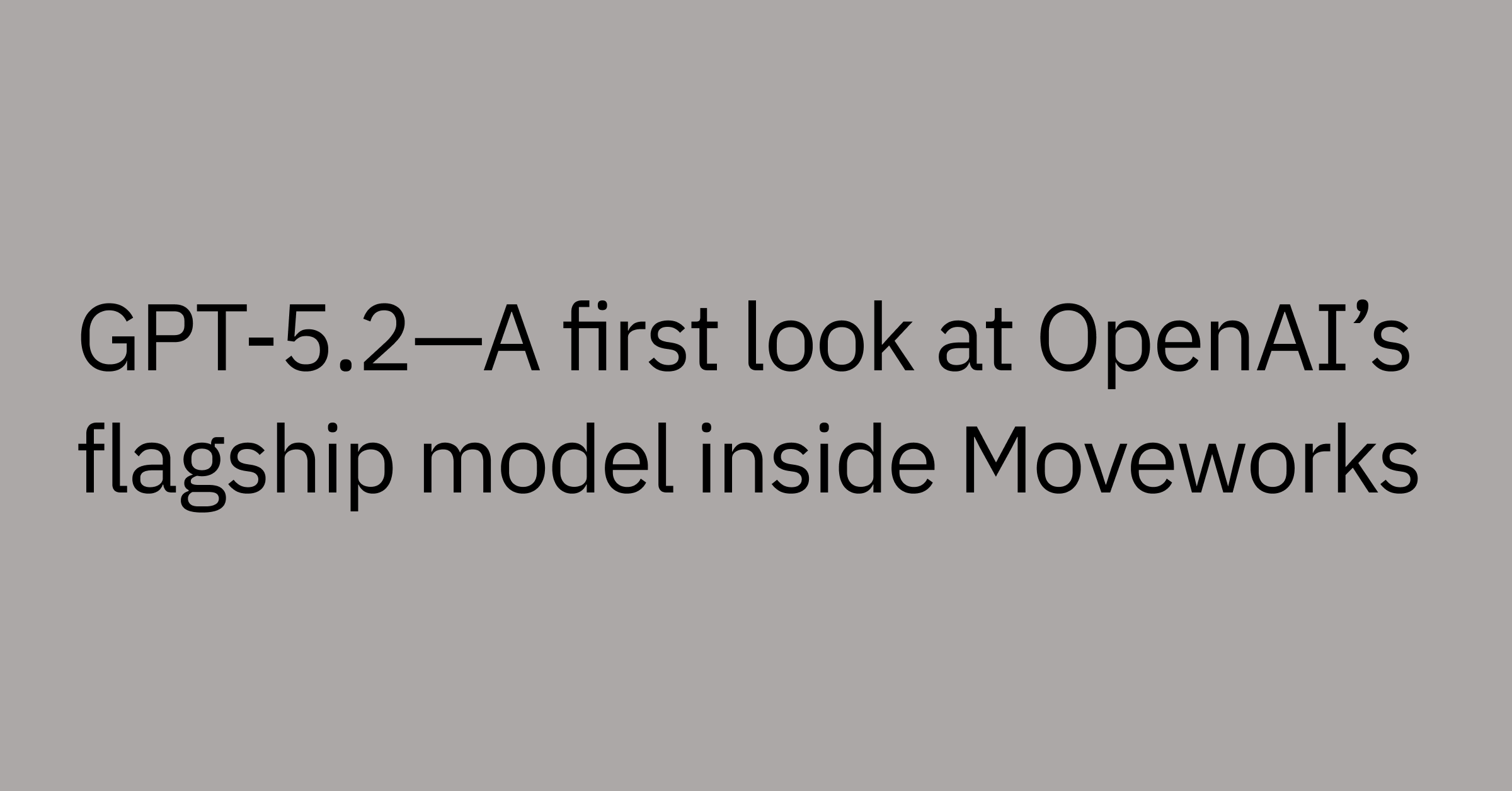Table of contents
Remember Clippy, the annoying paperclip assistant in MS Office? Decades ago, online assistants like Clippy were simple automation tools with limited capabilities. But with the rise of new technologies, AI adoption in business has accelerated, with a new wave of intelligent systems called “copilots” emerging as powerful productivity tools.
These AI-powered copilots are not your average paper-pushing assistants. Unlike Clippy, copilots integrate seamlessly into existing systems, leveraging massive knowledge bases and advanced natural language processing to deliver helpful, human-like assistance. Whether it's answering HR questions, resolving IT tickets, or even writing personalized outreach emails, these digital sidekicks promise to transform how work is done.
That said — and given that copilots are still new on the scene — there are still a lot of open questions, including what can they actually do?
In this blog, we’ll cover real-world copilot use cases across the enterprise and the benefits they can provide by driving innovation and ROI. Specifically, you’ll learn:
- What copilots are, and how they work
- How copilots increase productivity, efficiency, and tech stack ROI
- High-value use cases in IT, HR, finance, facilities and more
- Challenges to consider
- Where copilots are heading next
This is to say that the days of Clippy are long gone. Join us as we explore this rapid evolution in AI and see how leaders are putting copilots to work across their organizations.
What can you use a copilot for?
An AI copilot is a conversational interface that uses large language models (LLMs) to support users in various tasks and decision-making processes across multiple domains within an enterprise environment. By leveraging LLMs, AI copilots possess the capability to understand, analyze, and process vast amounts of data.
AI copilots are most valuably used to:
- Provide proactive, context-aware assistance: AI copilots can proactively respond to user needs based on contextual information, ensuring relevant and timely support during critical decision-making processes.
- Automate repetitive tasks: Copilots take on high-volume, mundane work like filling forms, updating records, transferring files, or collecting data.
- Surface insights from data: AI copilots can quickly process large amounts of information, identify patterns and trends, and present actionable insights to drive effective decision-making.
- Streamline communication workflows: Copilots handle common communication tasks like reminding employees about approvals, alerting leaders of issues, or sharing company news updates.
- Orchestrate processes across systems: Copilots integrate with multiple platforms to automate cross-application workflows from end to end.
The common thread is copilots applying intelligence to simplify daily work — all so employees can be more productive, empowered, and engaged. Stay tuned for even more specifics on how AI copilots can be used to deliver value across the enterprise.
Key components and technologies involved
AI copilots blend several advanced technologies to deliver sophisticated automation and assistance, including:
- Conversational interface: Technologies like large language models (LLMs), natural language processing (NLP), and natural language understanding (NLU) can be used to parse and understand free-form requests. Strategies like semantic analysis, entity extraction, and intent recognition enable fluent dialogues.
- Reasoning engine: AI reasoning mimics human-like cognition for assessing issues and devising solutions. Knowledge graphs, machine learning, and pattern recognition can be used to figure out next steps.
- Task automation: Robotic process automation integrates with business systems via APIs and plug-ins to execute routine workflows, functioning as virtual hands to take action.
- Generative summarization: AI models like GPT-4 synthesize information and generate written explanations in simple language tailored to employee inquiries.
- The ability to take action across systems: Seamless coordination allows smooth hand-offs between conversational understanding, solution strategizing, process automation, and summarization abilities.
- Trust mechanisms: Features like verification checks, confidence scores, citation tracking, and human oversight preserve accountability and safety while leveraging AI.
The seamless integration between these core capabilities empowers the flexibility, intelligence, and scalability needed for a copilot to deliver frictionless support across complex enterprise environments.
The evolution from chatbots to copilots in the enterprise
Early chatbots were built with dialog flows, offering simplistic menus and canned answers. Fundamentally, they lacked the contextual understanding and workflow automation abilities needed in enterprise environments.
Here at Moveworks, we set a new standard with our next-gen copilot combining natural conversations, enterprise integrations, and end-to-end automation. The Moveworks Copilot (now Moveworks AI Assistant) understands requests in context, asks clarifying questions, and takes action across systems and apps to resolve issues.
Microsoft and other tech giants have also introduced copilots aimed at boosting productivity in the workplace. These efforts show the momentum building behind conversational AI and validate the tremendous value copilots can provide. While many of these other tools are focused on general assistance, these launches represent important steps in making AI accessible to more organizations.
Moveworks complements these broader copilots with deep vertical expertise and enterprise integrations tailored to specific business systems and workflows. Our specialized approach unlocks more advanced automation possibilities across the tech stack.
As AI copilots continue to evolve, they will redefine how businesses operate with personalization, process improvement, and elevated user experiences. The future points towards copilots that combine human-like conversations with broad automation capabilities across devices, apps, and workflows.
Understanding the potential of copilot use cases
Identifying the right copilot use cases for your organization is key to unlocking the transformative potential of this technology. But navigating the vast landscape of copilot use cases isn't just about embracing a trendy technology; it's about transforming the way we work.
First and foremost, understanding impact begins with the numbers. Statistics reveal the tangible benefits and game-changing efficiencies organizations gain by leveraging copilots. From slashing resolution times to boosting user satisfaction, the data tells a powerful story of real-world impact.
Nothing speaks louder than real-life success, though. With copilot adoption over 70% at Jamf, Mercari cutting IT tickets by 74%, and Hearst using copilots to resolve more than 50% of support issues across departments, these examples showcase the potential waiting to be unlocked by AI.
But use cases aren't just about solving problems. They spark innovation by transforming how teams approach challenges, creating a ripple effect of adoption that changes industries.
With that, let's zoom in on two core benefits unlocked by strategic copilot use case identification: productivity and efficiency.
- Copilots boost productivity by seamlessly integrating into workflows. These digital sidekicks allow teams to accomplish more in less time by automating rote tasks. It's not just about working differently; it's working smarter.
- Copilots take efficiency to the next level by optimizing processes and ensuring every action has a purpose. For support teams, this means increased capacity to handle complex issues with finesse. Copilots also deliver an ROI boost for tech stack investments. The efficiency gains and innovation strides enabled by copilots create value that far exceeds their cost. It's about getting the most from your tools.
In the arc of technological progress, copilot use cases represent a pivotal breakthrough. From driving productivity to spurring innovation, these digital sidekicks are rewriting the playbook. The time is now to identify high-impact use cases and unleash the potential of copilots. Now, let's dive into the details...
Top 140 copilot use cases
The following 140 use cases showcase the diverse capabilities of the Moveworks Copilot (now Moveworks AI Assistant) across common enterprise systems. As you read through the list, note how our solution is uniquely positioned to not only search and pull information from hundreds of enterprise systems but also take action.
We created the Moveworks AI Assistant to be an easy-to-adopt, out-of-the-box platform. But we understand that every business is different. That’s why we also provide the ability for organizations to extend the platform to as many use cases as possible with these resources:
- Plugin Library: Want more than 140 use cases? Discover and add plugins to your Moveworks AI Assistant with our Plugin Library.
- Creator Studio: Creator Studio lets you extend Moveworks to every enterprise application. Build your own powerful, custom use cases and easily create fluid conversations, data lookups, and proactive alerts.
Application management system (AMS) copilot use cases
Moveworks integrates with application management systems to automate workflows, including:
- Application maintenance reminders: Send proactive notifications to IT staff to perform routine maintenance tasks on enterprise applications.
- Upcoming application outages: Keep employees informed of planned application outages, scheduled maintenance windows, and any resulting system downtime.
- Submission reminders: Remind employees to complete and submit required forms by the deadline to avoid compliance issues.
- Check app status: Enable employees to check the status of an application in real time, providing visibility into system availability and minimizing disruptions.
- Check app logs: Allow employees to view logs for a specific application, facilitating troubleshooting and issue resolution.
- Search app users: Provide employees with a way to search for users of a particular application, streamlining access management and security.
- Check app configuration: Allow employees to view the configuration settings for an application, facilitating troubleshooting and customization.
- View app usage: Enable employees to view usage statistics for a specific application, providing insights into adoption and utilization.
- Request app access: Enable employees to quickly request access to specific applications, improving access management and security.
- Report app issues: Empower employees to easily report issues with applications, improving application support and minimizing downtime.
- Request app upgrade: Enable employees to request application upgrades, ensuring that they have access to the latest features and improvements.
- Request app removal: Streamline the process of removing applications that are no longer needed, improving system performance and reducing clutter.
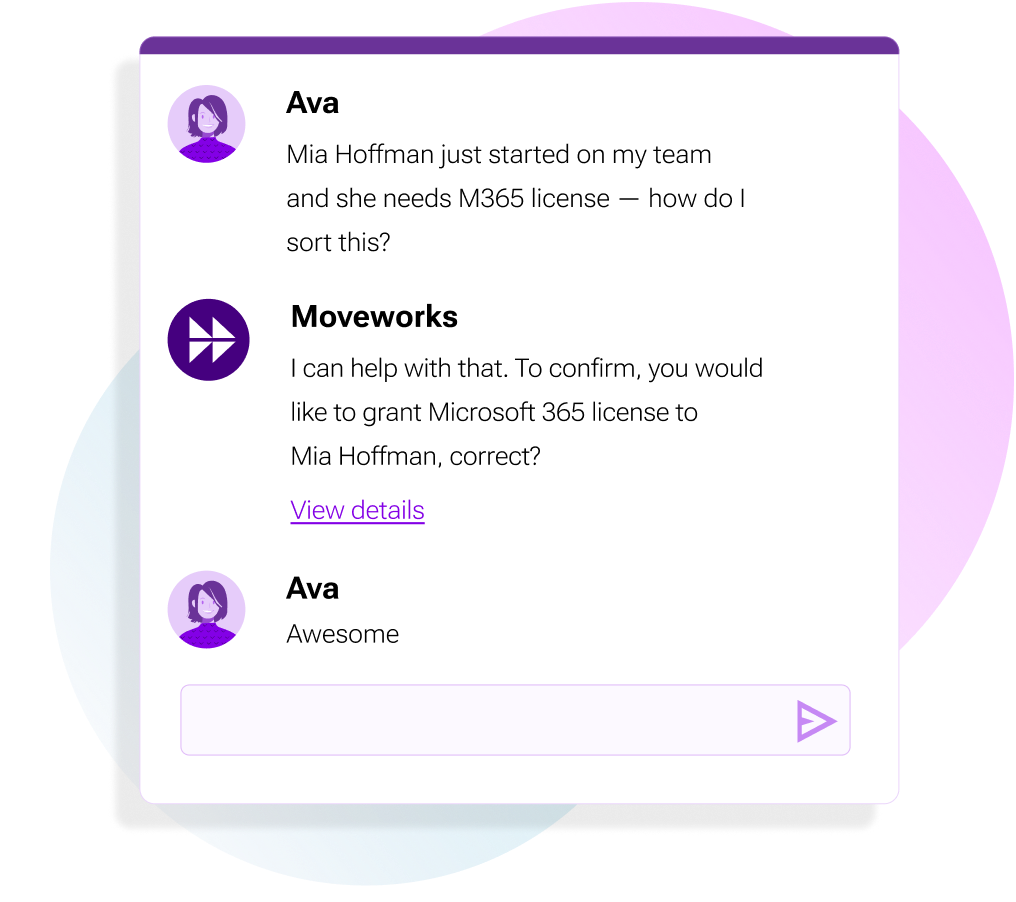
Collaboration system copilot use cases
Collaboration platforms, like Microsoft Teams and Slack, are prime for our AI Assistant to add value with:
- Meeting reminders: Send automated reminders to employees before scheduled meetings to reduce no-shows and improve attendance rates.
- Task notifications: Proactively notify employees of upcoming tasks and deadlines to improve productivity and reduce missed assignments.
- Document updates: Notify employees of updates to important documents or knowledge articles to ensure they always have access to the latest information.
- Collaboration metrics: Send regular updates on collaboration metrics such as team performance, project progress, and communication patterns to help employees stay informed and identify areas for improvement.
- New employee onboarding: Send welcome messages and notifications to new employees during the onboarding process to help them feel welcome and facilitate a smooth transition into the company culture.
- Find meeting room availability: Help employees quickly find available meeting rooms and schedule meetings.
- Lookup employee availability: Enable employees to check the availability of their colleagues before scheduling meetings or assigning tasks.
- Search for shared files: Allow employees to easily search for and access shared files across collaboration systems.
- Set up a meeting: Guide employees through setting up a meeting by asking for information such as date, time, attendees, location, and any special requirements.
- Create a team: Assist employees in creating a new team by asking for information such as team name, purpose, members, and any necessary permissions.
- Troubleshoot technical issues: Help employees resolve technical issues related to the collaboration platform by asking questions to narrow down the problem, presenting knowledge base articles, or offering to connect with IT support.
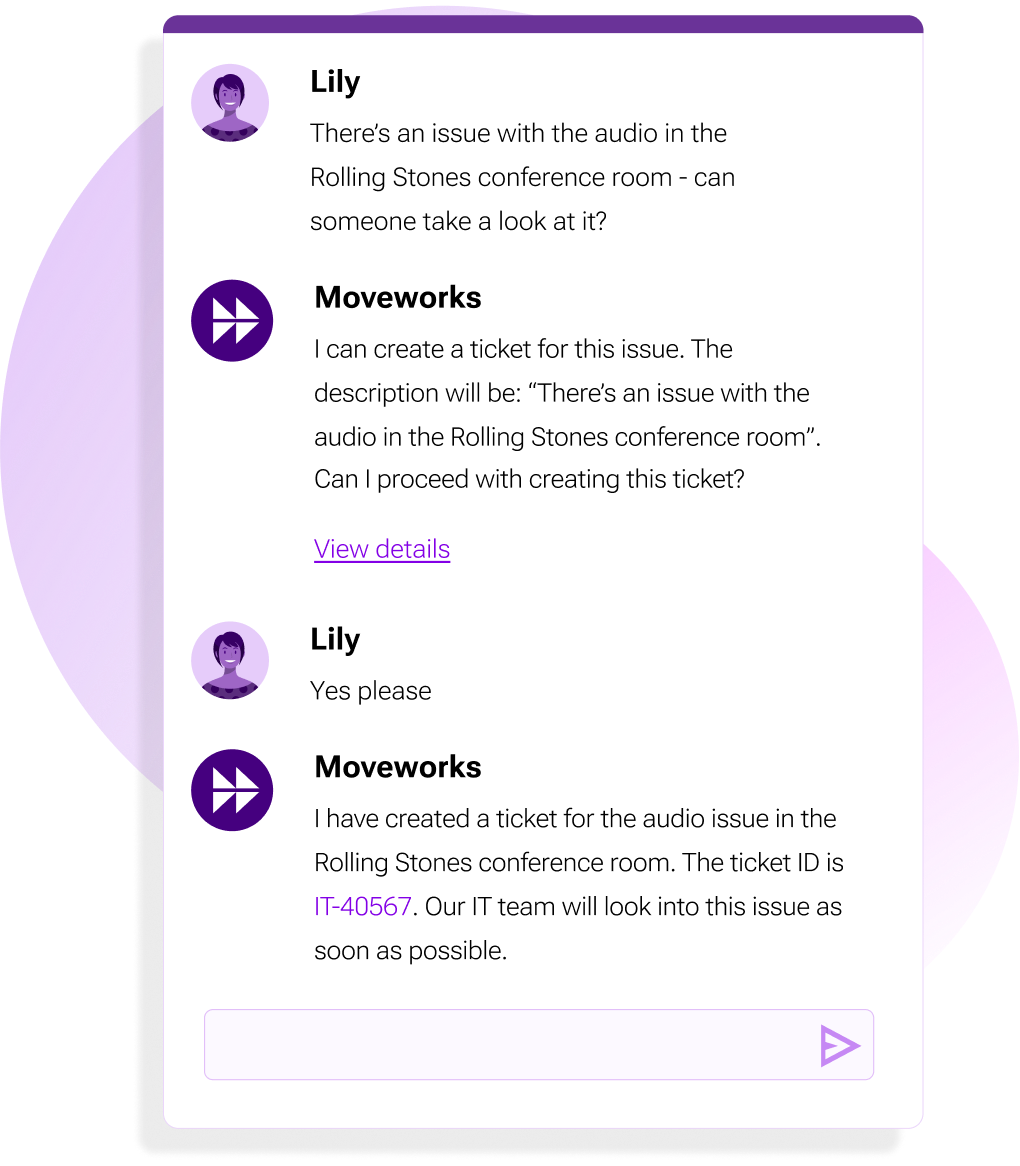
Customer relationship management (CRM) system copilot use cases
From lead handling to order management, Moveworks AI Assistant supercharges CRM systems by injecting AI into repetitive workflows, such as:
- Deal milestone alerts: Notify sales reps when a deal reaches a key milestone, such as a contract signing or payment received.
- Meeting reminders: Send automated reminders to employees for upcoming client meetings, reducing the risk of missed meetings and improving customer relationships.
- Customer feedback requests: Prompt employees to request feedback from customers after a successful interaction or sale, helping to improve customer satisfaction and loyalty.
- Product launch updates: Notify employees of updates and changes related to upcoming product launches, helping to ensure that everyone is on the same page and ready for launch day.
- Lead status updates: Alert sales reps when a lead they’re working on has a change in status, such as becoming a qualified lead or moving into a new stage of the funnel.
- Lookup customer information: Allow employees to quickly search for customer information, such as contact details, order history, and support tickets, to provide better customer service.
- Check open support tickets: Enable employees to easily retrieve a list of open support tickets for a specific customer, so they can follow up and provide timely assistance.
- Check order status: Provide employees with a simple way to check the status of a customer’s order, including tracking information and delivery dates
- Update customer information: Allow employees to easily update customer information in the CRM system, ensuring accurate and up-to-date records.
- Qualify leads: Streamline the lead qualification process by guiding employees through a series of questions to determine if a lead is a good fit for the company’s products or services.
- Resolve customer issues: Help employees quickly resolve customer issues by guiding them through a series of questions to gather necessary information and then providing recommended solutions or escalation paths.
- Schedule follow-up calls: Make it easy for employees to schedule follow-up calls with customers in the CRM system, ensuring that customers receive timely and consistent communication.
- Create customer quotes: Guide employees through the process of creating a customer quote in the CRM system, ensuring that all necessary information is captured and the quote is accurate.
- Account overview: Enable quick access to comprehensive overviews of customer accounts, including transaction history, communication logs, and upcoming touchpoints.
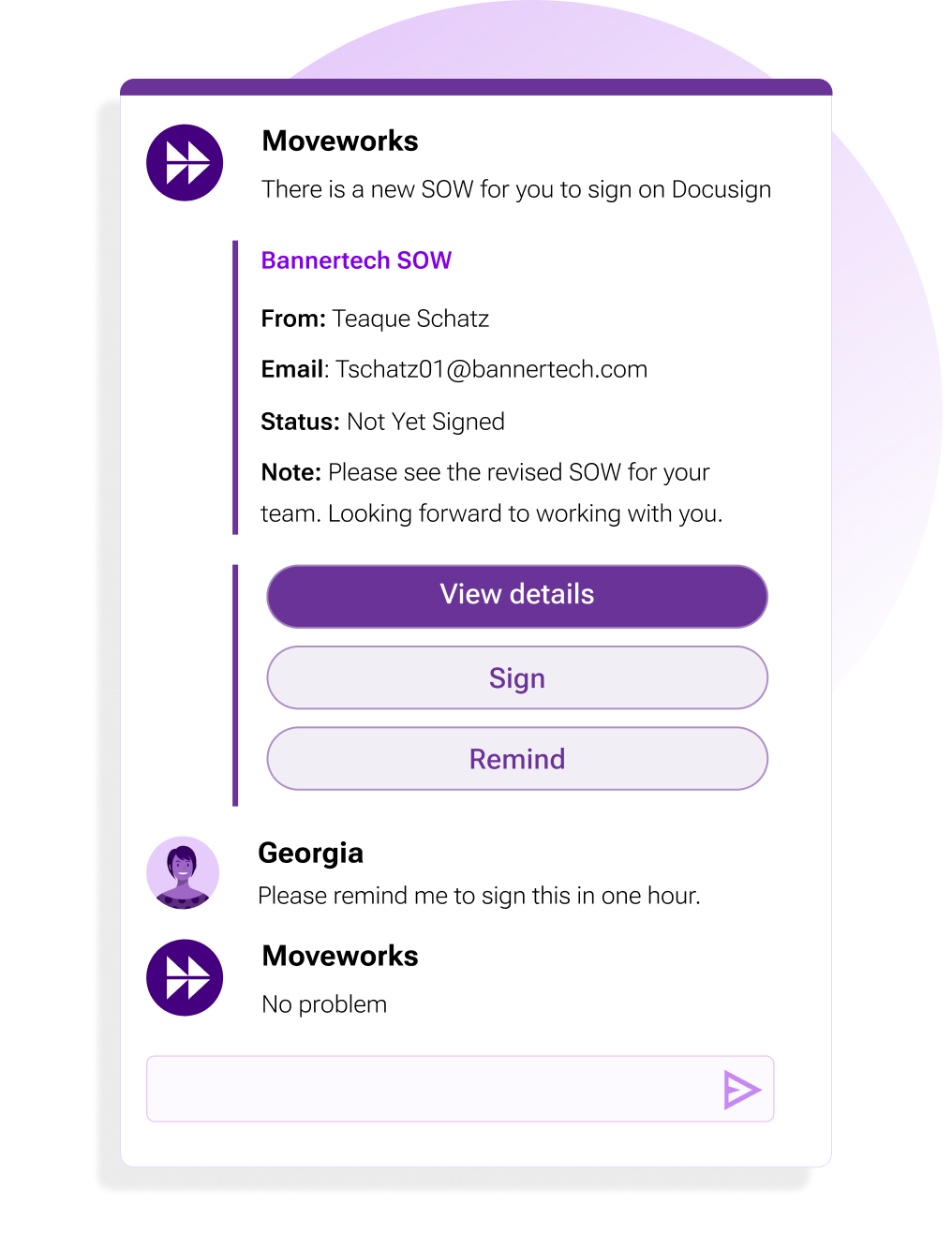 automatically-notify-sales-teams-on-deal-milestones
automatically-notify-sales-teams-on-deal-milestones
Financial management systems (FMS) copilot use cases
Managing budgets, approving purchases, and tracking expenses become easier with an AI copilot optimized for your financial systems. Here are just a few of the use cases possible with Moveworks:
- Budget deadline reminder: Send automated reminders to department heads of upcoming budget submission deadlines to ensure timely and accurate budgeting.
- Invoice approval notification: Notify managers when an invoice is waiting for their approval to prevent delays in payment processing.
- Payment due alerts: Alert employees when a payment is due, so they can ensure on-time payments and avoid any late fees.
- Expense report submission reminder: Send automated reminders to employees to submit their expense reports before the deadline, streamlining the reimbursement process.
- Financial report publishing notification: Notify relevant stakeholders when financial reports are published to ensure timely review and decision-making.
- Check budget status: Allow employees to quickly view the current status of their department’s budget and any remaining funds.
- Lookup invoice details: Provide employees with a convenient way to search for and view details of a specific invoice, such as the amount, date, and vendor information.
- Check payment status: Enable employees to check the status of a payment, such as whether it has been approved, processed, or paid.
- Search purchase orders: Allow employees to search for a specific purchase order and view details such as the vendor, date, and total amount.
- Lookup expense details: Provide employees with a convenient way to search for and view details of a specific expense report, such as the total amount, date, and approver information.
- Submit expense report: Simplify the process of submitting expense reports by guiding employees through the necessary steps, ensuring accuracy and timely reimbursement.
- Approve purchase requests: Allow managers to quickly review and approve purchase requests, streamlining the procurement process and ensuring timely delivery of necessary goods and services.
- Manage budget: Provide a user-friendly interface for employees to manage their departmental budgets, making it easy to track expenses and make informed decisions.
- Adjust payroll deductions: Allow employees to update their payroll deductions for taxes, insurance, and other benefits, reducing administrative overhead and ensuring accurate payments.
- Resolve payment disputes: Assist employees in resolving payment discrepancies, such as incorrect payment amounts or missing payments, by collecting necessary information and routing it to the appropriate support team.
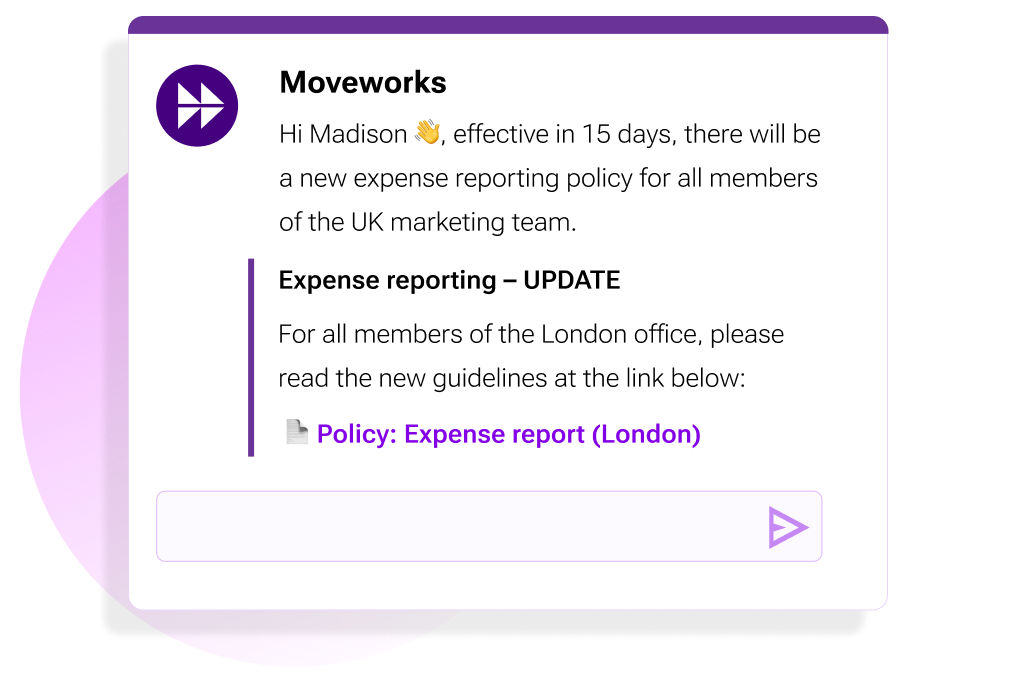 easily-inform-groups-on-policy-updates
easily-inform-groups-on-policy-updates
Identity and access management (IDAM) system copilot use cases
Secure access and seamless onboarding are crucial, and our copilot handles password resets, permissions, and more to keep your systems protected.
- Access request status updates: Send updates to employees regarding the status of their access requests, including approvals or rejections, to keep them informed about the progress of their requests.
- Compliance training reminders: Notify employees about upcoming compliance training sessions, including the date, time, and location, and provide them with links to relevant resources to prepare for the training.
- Multi-factor authentication requests: Prompt employees to complete multi-factor authentication when accessing sensitive systems or applications to help protect against unauthorized access.
- Security incident alerts: Send notifications to employees in the event of a security incident (e.g. data breach, phishing attempt), and provide them with instructions for how to protect themselves and report any suspicious activity.
- Lookup user access: Enable employees to search for and view details of a specific user’s access to different systems and applications.
- Check password expiration: Allow employees to quickly view the expiration date of their passwords to ensure they stay up to date with security protocols.
- View access requests: Provide employees with a convenient way to view the status of their access requests for different systems and applications.
- Reset password: Guide employees through the process of resetting their password, minimizing the need for IT support and ensuring secure access to company systems.
- Request access: Help employees request access to specific applications or systems, ensuring proper authorization and reducing security risks.
- Update profile information: Walk employees through updating their personal information, ensuring that their accounts are up-to-date and that they receive relevant communications.
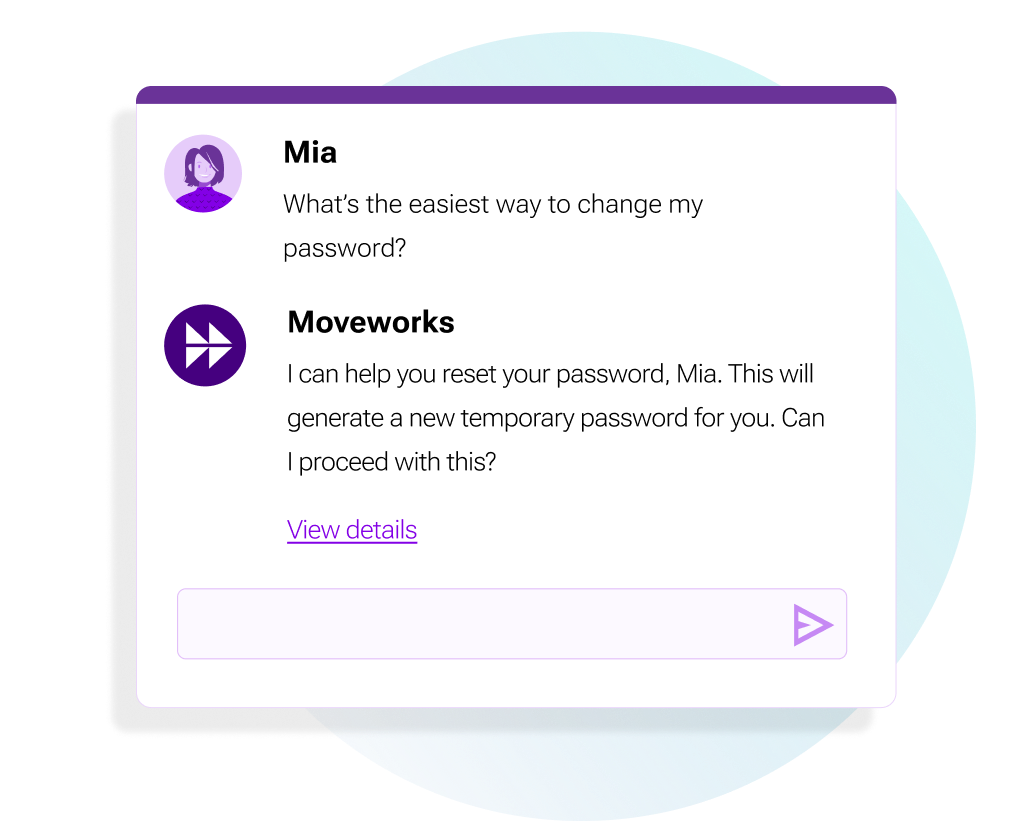 hassle-free-account-access
hassle-free-account-access
IT operations system copilot use cases
Whether it's monitoring infrastructure or troubleshooting code, the Moveworks AI Assistant brings AI assistance to all aspects of IT ops.
- Scheduled maintenance notifications: Notify employees of scheduled maintenance windows for IT systems and applications to minimize disruption and downtime.
- System outage alerts: Send real-time alerts to IT teams and affected employees when a critical system or application is down to enable quick response and resolution.
- New IT service launches: Announce the launch of new IT services or applications to employees and direct them to relevant knowledge articles for quick adoption.
- Incident updates: Keep employees informed about the status of ongoing IT incidents and provide relevant updates and next steps.
- On-call reminders: Remind on-call employees of their duty schedule and provide them with relevant resources to ensure prompt incident resolution.
- View server status: Allow employees to quickly check the status of servers and their usage to improve system uptime and performance.
- Lookup system configuration: Enable employees to retrieve information about system configurations to diagnose and resolve technical issues.
- Retrieve network access details: Allow employees to easily search for and retrieve details about their network access and permissions, simplifying IT operations.
- View on-call schedule: Allow employees to view the on-call schedule for their team or department, ensuring proper coverage and reducing the risk of missed alerts.
- Check license usage: Provide employees with a way to view the number of licenses in use for specific software or services, helping to optimize licensing costs.
- Lookup asset details: Allow employees to search for and view detailed information about company assets, such as computers, printers, or mobile devices.
- Troubleshoot API error: Help employees quickly diagnose and fix errors that occur when calling APIs, improving system reliability and reducing downtime.
- Configure environment variables: Assist employees with configuring environment variables for applications, ensuring they have access to the correct resources and services.
- Deploy application: Streamline the deployment process for employees by providing a guided workflow that automates deployment steps, reducing errors and time spent on manual processes.
- Debugging code: Help employees identify and fix bugs in their code by asking targeted questions about the problem and providing relevant documentation or resources.
- Provision infrastructure: Guide employees through the process of provisioning new infrastructure, ensuring that resources are properly allocated and configured for the application.
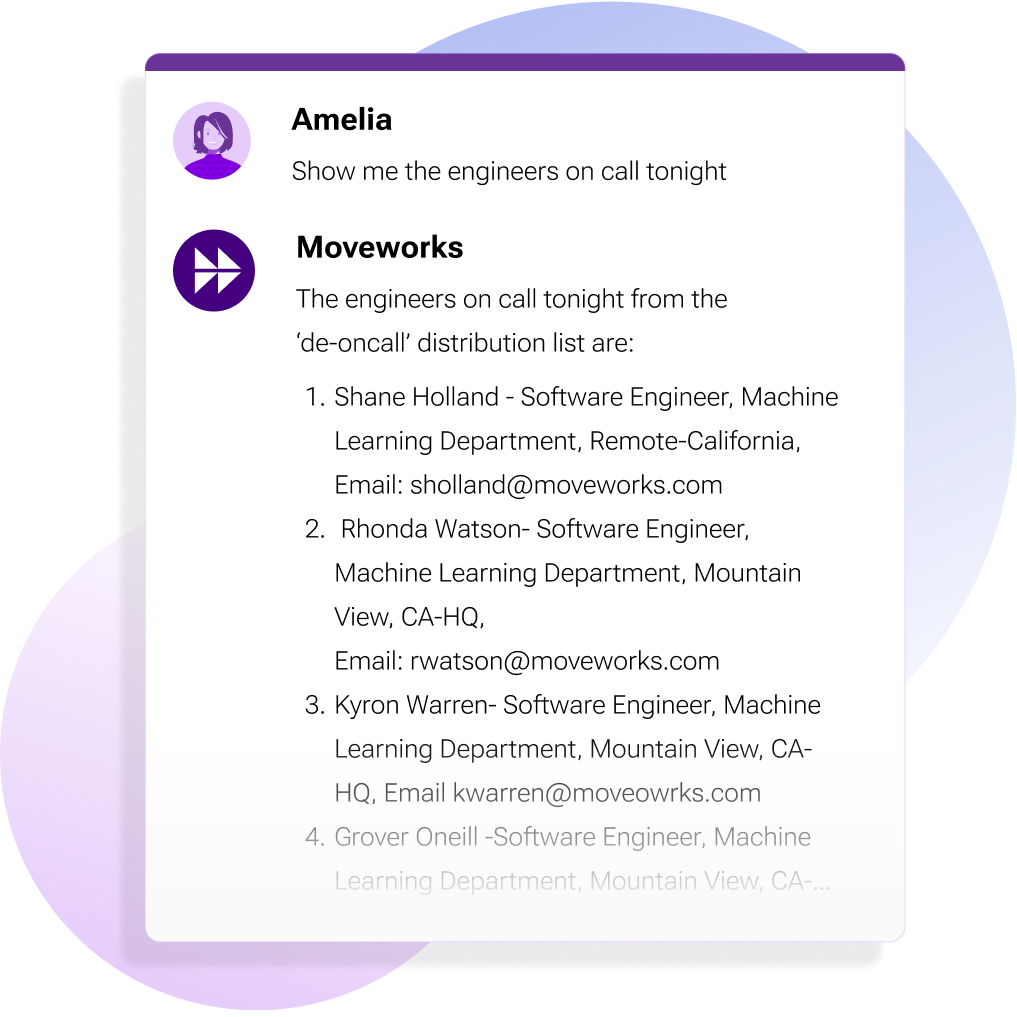 access-real-time-engineering-data
access-real-time-engineering-data
Human resource information systems (HRIS) copilot use cases
HR systems are full of time-consuming tasks perfect for automation, from onboarding new hires to managing benefits. The Moveworks AI Assistant can help with many use cases, including:
- Performance review reminder: Send automated reminders to employees and managers when it is time for performance reviews, ensuring timely completion of the process.
- Onboarding checklist: Send a daily email to new hires with a checklist of tasks they need to complete to be fully onboarded, making sure that all the necessary steps are done in a timely manner.
- Benefits enrollment period: Notify employees when the benefits enrollment period is open, guiding them to the appropriate forms and resources to select their desired benefits.
- Compliance training: Send reminders to employees to complete required compliance training, helping to ensure that employees are knowledgeable and compliant with company policies and procedures.
- View benefits summary: Allow employees to check their current benefits coverage and plan details, such as medical, dental, and vision.
- Lookup 401k balance: Provide employees with a way to check their current balance in their 401k account.
- Search for benefits providers: Help employees find in-network benefits providers by searching for doctors, dentists, or other medical professionals in their area.
- Look up onboarding status: Allow employees to check the status of their onboarding process, including tasks completed and remaining tasks.
- Lookup payroll information: Enable employees to easily access their payroll information, such as pay stubs or tax documents.
- Check performance review status: Allow employees to check the status of their performance review process, including upcoming deadlines and completed reviews.
- Update personal information: Guide employees through the process of updating their personal information, such as contact details and emergency contacts, to ensure accurate records and effective communication.
- Onboarding: Provide a streamlined onboarding experience for new hires by guiding them through the necessary paperwork, training, and orientation materials.
- Report an incident: Guide employees through the process of reporting workplace incidents or safety concerns to ensure prompt resolution and compliance with company policies.
- Change benefits enrollment: Enable employees to easily modify their benefits enrollment details without the need for HR intervention.
- Find health insurance information: Provide employees with a simple way to access important information about their health insurance benefits, including coverage details and provider information.
- Check retirement plan balance: Allow employees to quickly view their retirement account balance and other important details about their retirement plan.
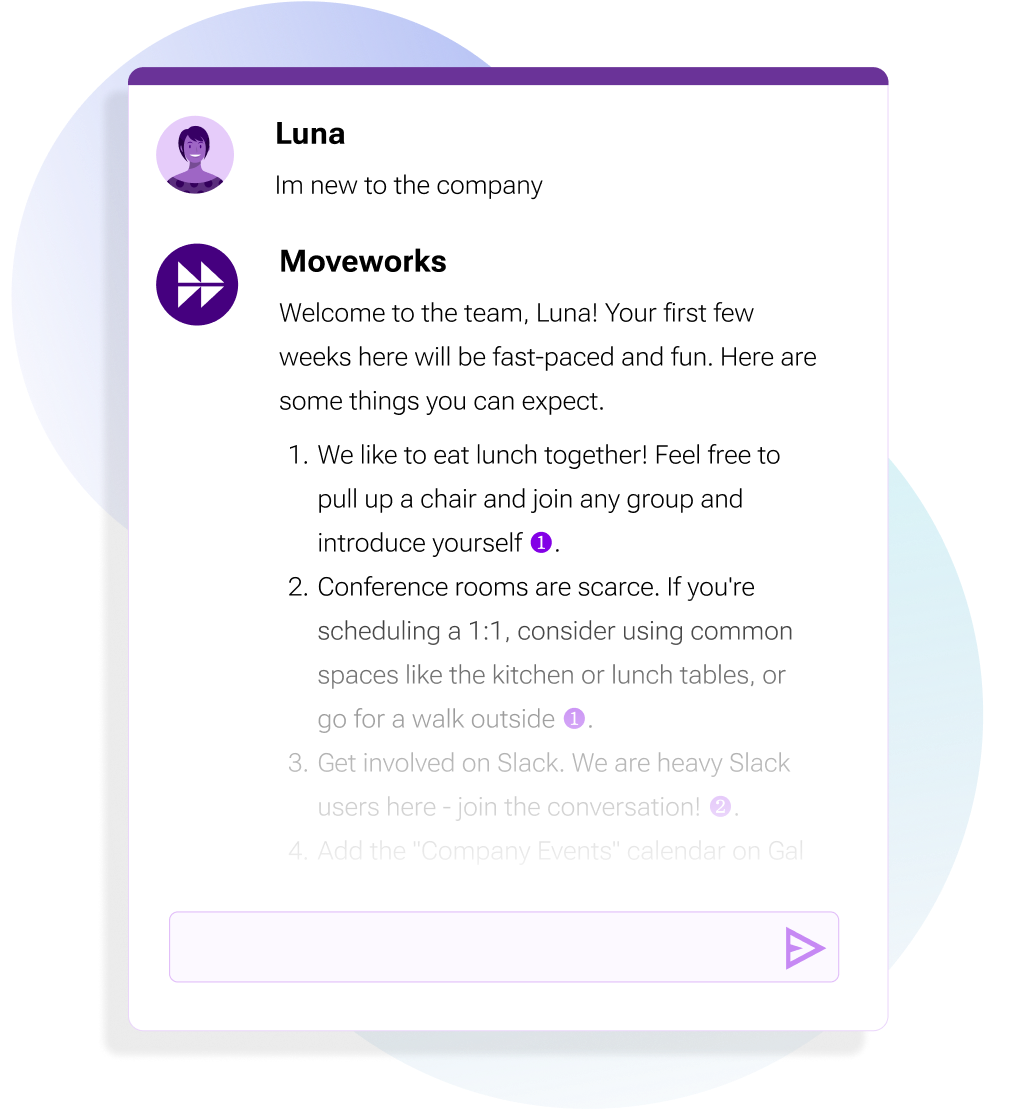
Marketing system copilot use cases
Moveworks integrates with marketing platforms to help launch campaigns, analyze performance, create compelling content, and more:
- Campaign launch notifications: Send notifications to employees when a new marketing campaign is launched, including key details such as the target audience and goals.
- Performance alert: Notify marketing teams of changes in website traffic, engagement rates, or other KPIs to identify trends and react quickly to any issues.
- New content alert: Keep content teams informed of new articles, videos, or other assets that have been added to the company’s marketing library.
- Website analytics report alert: Notify key stakeholders when website analytics reports are available to ensure timely review and action on website performance.
- Content approval request: Notify content approvers when new marketing content has been submitted for review and approval.
- Campaign performance metrics: Allow employees to quickly access key metrics for marketing campaigns, such as click-through rates, conversion rates, and ROI.
- Lead status lookup: Provide sales representatives with an easy way to look up the status of a particular lead, including recent interactions, notes, and next steps.
- Event attendee list: Enable event coordinators to quickly pull up a list of attendees for a particular event, along with their contact information and any special requirements.
- Asset inventory lookup: Allow employees to search for specific marketing assets, such as brochures, banners, or swag, and see the current inventory levels.
- Competitor analysis: Provide marketing teams with a way to quickly gather information on key competitors, such as market share, pricing, and product offerings.
- Request campaign assistance: Guide employees through a series of questions to understand their marketing campaign needs and present a knowledge article or connect them to the appropriate team for support.
- Find marketing materials: Help employees find the right marketing materials (e.g. brochure, flyer, product video) for their campaign by asking a few simple questions and directing them to the appropriate resources.
- Create a new campaign: Help employees quickly create new marketing campaigns with a guided path that collects key information such as target audience, messaging, and budget.
- Troubleshoot campaign performance: Provide a guided troubleshooting path for employees to identify and solve issues with underperforming campaigns, improving overall campaign ROI.
- Request creative services: Streamline the process of requesting creative services, such as design or copywriting, with a guided path that collects the necessary information and triggers the appropriate team to fulfill the request.
- Request social media posts: Enable employees to easily request social media posts for upcoming campaigns or events with a guided path that ensures proper messaging and visuals are included.
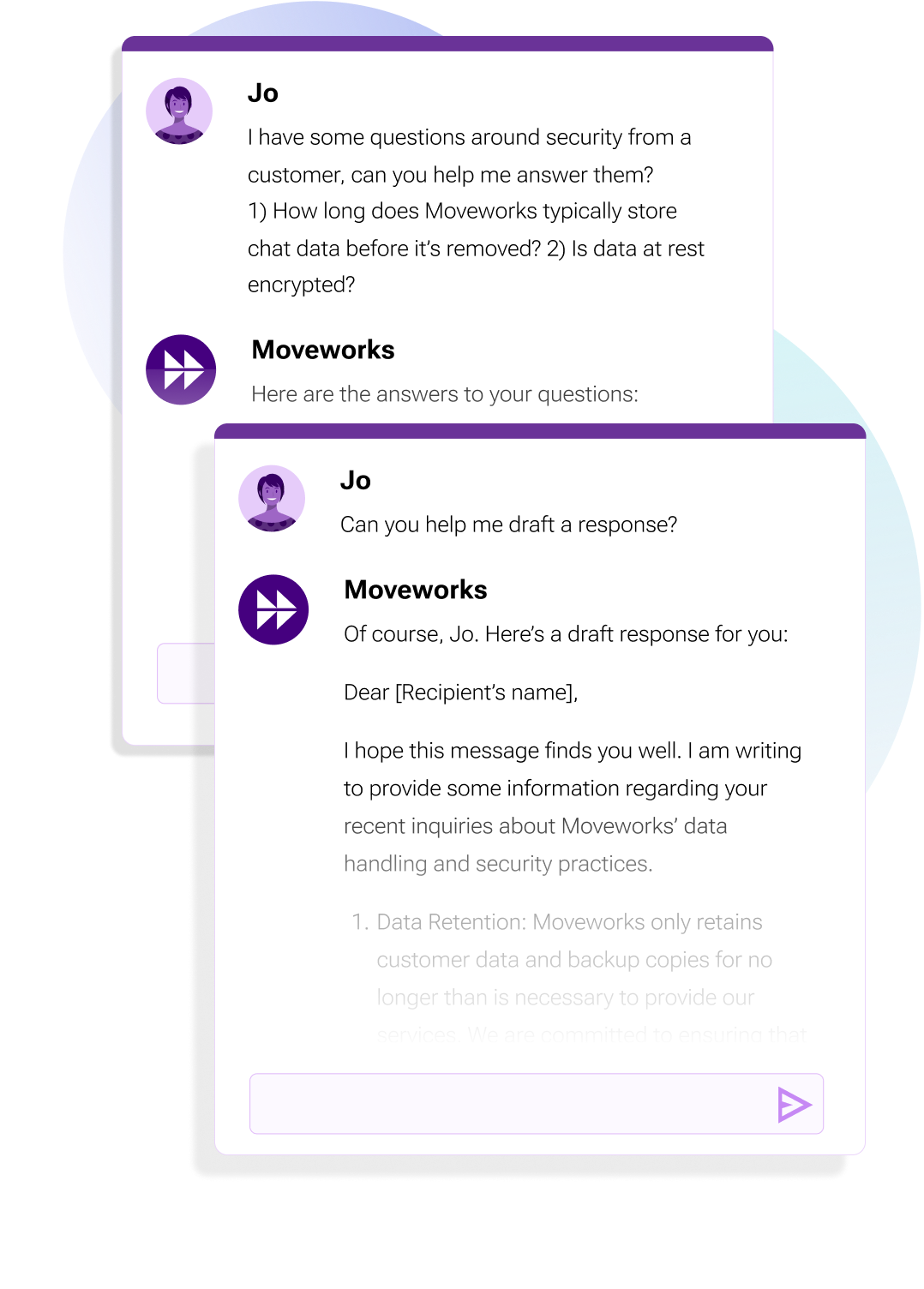 generate-answers-and-reponses-to-prospect-emails
generate-answers-and-reponses-to-prospect-emails
Procurement system copilot use cases
Moveworks helps streamline procurement in a number of ways, including:
- Purchase order approval requests: Notify managers when a new purchase order requires their approval, providing a quick link to the approval form.
- Delivery updates: Keep employees informed of delivery statuses for their procurement orders, providing proactive updates on any changes or delays.
- Contract expirations: Alert procurement teams when a contract is nearing its expiration date, prompting them to take action to renew or renegotiate the agreement.
- Request status updates: Keep requesters informed of the status of their procurement requests, sending proactive notifications as their request moves through the approval and fulfillment processes.
- Lookup purchase order: Allow employees to search for purchase orders by entering the PO number or supplier name and view the status, delivery date, and other details.
- Check requisition status: Enable employees to quickly check the status of their purchase requisitions, such as whether they have been approved, rejected, or pending review.
- Check vendor information: Enable employees to search for vendor information, such as contact details, payment terms, and purchase history, by entering the vendor name or ID.
- View catalog items: Allow employees to browse and search for items in the procurement catalog, view their descriptions, prices, and availability, and add them to their cart for purchase.
- View contracts: Allow employees to search for and view procurement contracts, such as supplier agreements, service-level agreements, and nondisclosure agreements, and their terms and conditions.
- Lookup inventory: Enable employees to search for inventory items by entering the SKU, product name, or category and view their stock levels, locations, and other details.
- View supplier scorecard: Enable employees to view the performance metrics and ratings of their suppliers, such as delivery times, quality, and responsiveness, and compare them against other suppliers.
- Request a purchase order: Guide employees through the process of requesting a purchase order, gathering necessary details and documentation, and submitting the request for approval.
- Track a purchase order: Help employees track the status of a purchase order, providing real-time updates on its progress through the procurement process.
- Find a supplier: Assist employees in finding a suitable supplier for a product or service, gathering requirements and preferences, and presenting a list of recommended suppliers to choose from.
- Report a procurement issue: Walk employees through the process of reporting a procurement issue, collecting relevant information, and notifying the appropriate parties to resolve the issue.
- Policy guidance: Assist employees in understanding and adhering to company procurement policies, including any required documentation or approvals, to ensure compliance and minimize risks.
- Payment inquiry: Help employees track payments made to vendors, including payment dates, amounts, and any discrepancies, to improve transparency and accuracy in financial transactions.
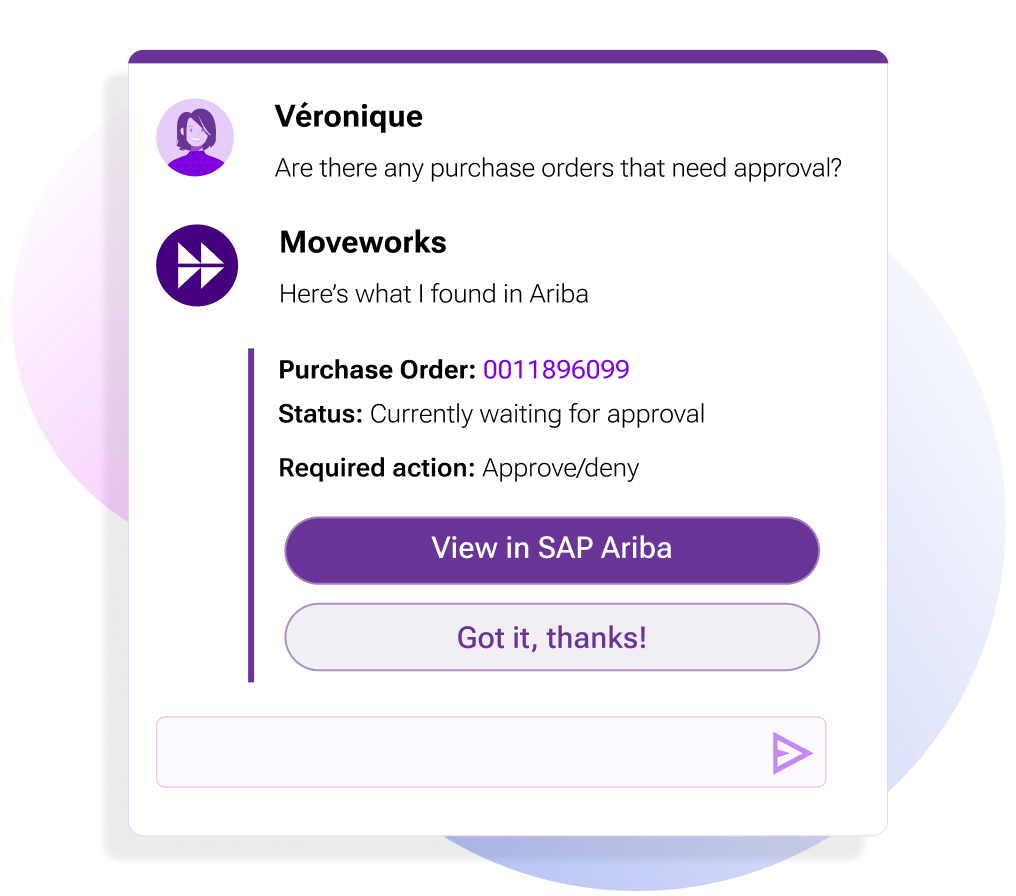
Project management system copilot use cases
AI meets project management with automated task coordination, status reporting, project workflow optimization, and more:
- Deadline reminder: Send proactive notifications to team members to remind them of upcoming project deadlines.
- Task assignment notification: Notify team members when they are assigned a new task, including the task details and due date.
- Project milestone update: Send a notification to the project manager when a team member updates the status of a project milestone. The notification should include the milestone name, the date of the update, and any comments or notes from the team member.
- Search projects: Allow employees to search for projects by name or ID and view their key details such as owner, status, and progress.
- View assigned tasks: Enable employees to view the tasks assigned to them for a particular project and their due dates and priorities.
- Check project budget: Provide employees with a quick way to check the budget status for a project, including expenses, revenue, and remaining budget.
- Lookup project contacts: Allow employees to search for project contacts by name, role, or organization and view their contact details and responsibilities.
- Create a new project: Guide employees through the process of creating a new project by asking questions about the project’s scope, timeline, budget, and team members.
- Update project status: Help employees update the status of a project by asking about completed tasks, pending tasks, and any issues or risks that need to be addressed.
- Assign tasks: Make it easy for employees to assign tasks to team members by asking about the task’s priority, due date, and who should be responsible for completing it.
- Schedule meeting: Streamline the process of scheduling a project-related meeting by asking about the attendees, agenda, preferred time slots, and any necessary resources.
- Report project progress: Help employees report project progress to stakeholders by guiding them through the process of preparing a summary of completed work, ongoing work, and upcoming tasks.
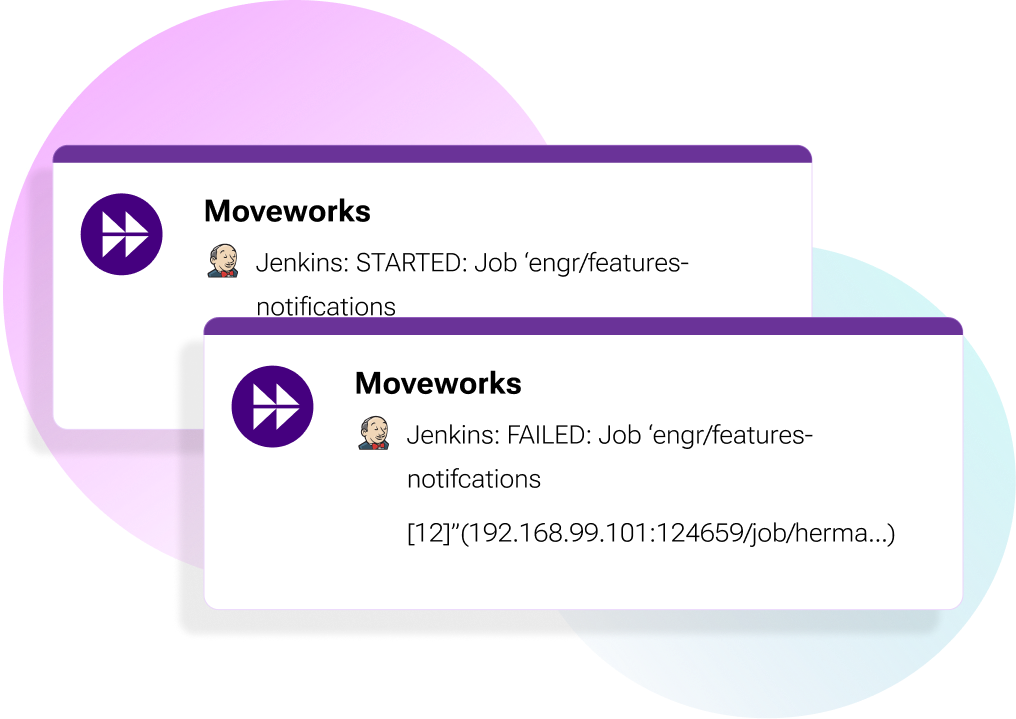 get-instant-notifications
get-instant-notifications
Challenges and considerations for copilots in the enterprise
Deploying copilots in the enterprise comes with important challenges and considerations around privacy, security, responsible AI, and more. Here are six key considerations:
- Privacy and data protection: With access to company systems and employee information, it's crucial for copilots to ensure privacy and data protection. Copilots should use anonymization, access controls, and data minimization to only capture necessary info. Encryption and secure storage help safeguard any collected data.
- Security: As a gateway to multiple backends, copilots must meet enterprise security standards. Using least privilege access, multi-factor authentication, and role-based permissions minimizes risks. Ongoing audits help identify and patch vulnerabilities.
- Responsible AI: Ethical AI practices like fairness, accountability, and transparency are essential. Copilots should avoid bias through diverse data and teams. Explainability tools can provide visibility into AI decision-making.
- Change management: Introducing an AI coworker requires thoughtful change management. Clear communication, training resources, and iterative deployment help build employee trust and adoption, while feedback channels allow users to guide copilot improvement.
- Measuring ROI: Hard metrics are needed to demonstrate copilot ROI. Tracking usage volumes, time savings, productivity gains, and cost reductions provides tangible proof of value. Surveys can also gauge soft benefits like employee satisfaction.
- Process alignment: For maximum impact, copilots require tight process alignment. Workflows should be streamlined before automation to avoid digitizing broken processes. AI recommendations must also fit organizational norms.
Deploying copilots at an enterprise scale comes with unique challenges. Addressing these considerations through responsible AI practices, change management, infrastructure readiness, and process alignment is key to rolling out automation successfully.
Future copilot trends in the enterprise
The copilot landscape is constantly evolving as new use cases emerge and AI capabilities advance. Let's explore what the future may hold for enterprise copilots.
- Emerging use cases: Yes, I just gave you 140 copilot use cases. But we're still just scratching the surface of potential copilot applications. Expect new use cases like automated contract analysis, predictive inventory management, and customer sentiment monitoring to gain traction. Intelligent assistants for roles like sales, engineering and finance will continue proliferating.
- Advances in copilot technology: On the tech front, more contextual conversations, predictive recommendations, and complex workflow automation will arrive through innovations like causal reasoning and probabilistic programming. Tighter integrations with data sources and backends will enable more robust automation.
- Potential impact on industries: Every industry stands to gain from advancing copilot capabilities. For healthcare, copilots can aid diagnoses and patient communication. In manufacturing, they optimize production and quality control. The public sector can better serve citizens with copilots for fielding requests and managing cases.
Start your copilot journey today
The potential of enterprise copilots is vast, but realizing it requires focus. We've only scratched the surface of high-value use cases that can transform workflows. The key is identifying applications and processes where conversational AI can drive the biggest productivity and efficiency gains.
The examples here showcase the diversity of tasks where copilots excel, from resolving help desk tickets to generating marketing campaign insights. But these are only the beginning. New use cases will continue proliferating across enterprises in the coming years.
Now is the time to strategically evaluate where injecting copilot capabilities can move the needle for your organization. Which teams stand to gain the most from an AI-powered assistant? What workflows or pain points demand a conversational overhaul? The opportunities abound.
At Moveworks, we're leading the shift towards an AI-first workforce. Our next-gen copilot seamlessly automates repetitive tasks, provides proactive support, and enables natural interactions across your tech stack.
We realize that the future of work is conversational — and it's already here. Empower your employees and unlock productivity at scale with the power of AI. Let's talk about exploring use cases tailored to your business needs. The potential is limitless — get started today.
Want to see our copilot in action? Get a live product tour of Moveworks.

